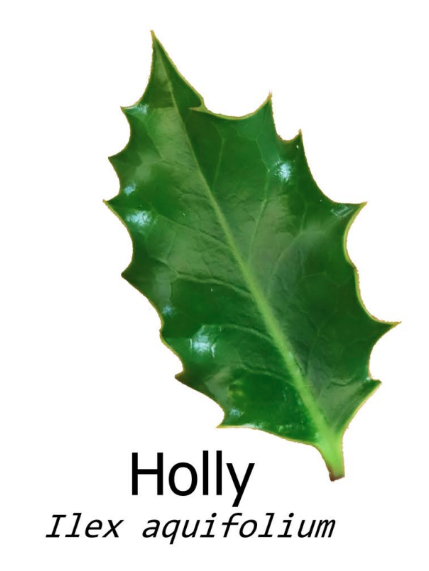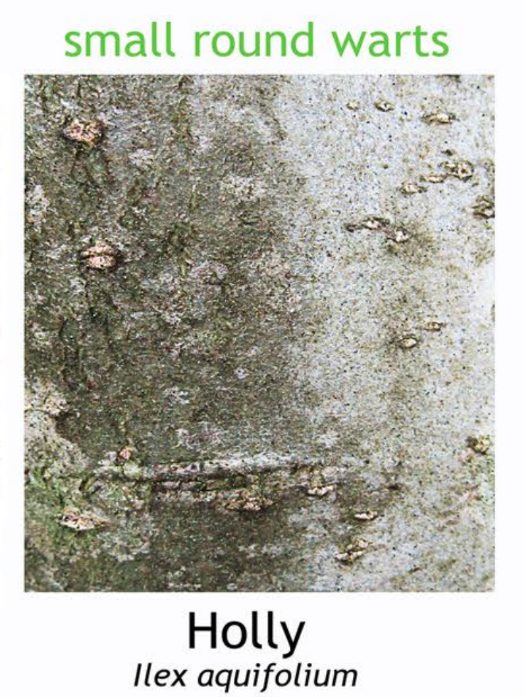A native evergreen tree species in Ireland, commonly found in woodlands, hedgerows, and gardens.
Recognising the Holly Tree:
-
Leaves: The leaves of the Holly tree are glossy, dark green, and leathery in texture. They are oval-shaped with spiny margins and arranged alternately along the stems.
-
Bark: The bark of the Holly tree is smooth and grey when young, becoming rougher with age and developing fissures and ridges.
-
Berries: Female Holly trees produce clusters of bright red berries in autumn, which persist through winter. These berries are a key characteristic of the tree and are toxic to humans but provide a valuable food source for birds.
-
Shape: Holly trees typically have a compact, pyramidal or conical shape, with dense foliage that provides year-round interest.
-
Thorns: Holly trees have sharp, spiny leaves which act as a deterrent against browsing animals and contribute to their distinctive appearance.


5 Interesting Facts about the Holly Tree:
-
Symbolism: Holly trees have long been associated with winter festivals and traditions, particularly Christmas. The evergreen foliage and bright red berries symbolise life, renewal, and hope during the darkest months of the year.
-
Historical Uses: In ancient times, Holly was revered as a symbol of protection and good luck. It was often planted near homes to ward off evil spirits and was used in rituals and ceremonies.
-
Wildlife Habitat: Holly trees provide valuable habitat and food for wildlife. Birds such as thrushes, blackbirds, and robins feed on the berries, while the dense foliage provides shelter and nesting sites for birds and small mammals.
-
Male and Female Trees: Holly trees are dioecious, meaning that individual trees are either male or female. Only female trees produce berries, which are pollinated by male trees.
-
Traditional Crafts: Holly wood is dense, hard, and fine-grained, making it ideal for carving and turning. It has been used in traditional crafts such as carving, inlay work, and tool handles.
Uses of the Holly Tree:
-
Decorative Use: Holly foliage with its glossy green leaves and bright red berries is widely used in Christmas decorations, wreaths, and floral arrangements. Its evergreen nature and festive appearance make it a popular choice for adding colour and texture to seasonal displays.
-
Traditional Medicine: In traditional herbal medicine, extracts from Holly leaves and berries were used to treat various ailments, including fevers, coughs, and rheumatism. However, caution should be exercised as the berries are toxic if ingested.
-
Landscaping: Holly trees are valued in landscaping for their ornamental qualities, year-round foliage, and attractive berries. They are often planted as specimen trees, hedges, or privacy screens in gardens and parks.
Contribution to Biodiversity:
-
Wildlife Habitat: Holly trees contribute to biodiversity by providing habitat and food for a variety of wildlife species. Their dense foliage and berries provide shelter, nesting sites, and a valuable food source for birds and small mammals, especially during the winter months when other food may be scarce.
-
Pollinator Support: The flowers of Holly trees provide nectar and pollen for bees and other pollinating insects in spring. While Holly is not a major source of nectar, it still contributes to the overall availability of resources for pollinators in woodland and garden ecosystems.
-
Soil Stabilisation: The dense root system of Holly trees helps stabilise soil, prevent erosion, and improve soil structure. This contributes to the health and stability of woodland ecosystems, particularly in areas prone to erosion or disturbance.
In summary, the Holly tree is recognisable by its glossy, spiny leaves and bright red berries. It holds cultural significance, provides valuable resources for wildlife, and contributes to biodiversity and ecosystem health in Ireland's woodlands, hedgerows, and gardens. Additionally, it serves as an important food source for birds and small mammals, supports pollinator populations, and enhances habitat complexity in natural ecosystems.
Images taken from the beautiful posters created by Phil Barnett and you can download these and/or purchase other great designs from his online shop.
